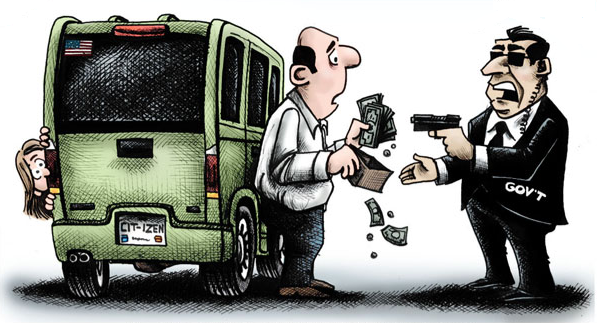April 20, 2022
Permission to republish original opeds and cartoons granted.
Report: Maine, New Mexico, Nebraska and North Carolina take bold steps to end civil asset forfeiture’s deprivation of property rights

By Robert Romano
Every year the federal, state and local governments seize about $3 billion of property via a process known as civil asset forfeiture, a perverse incentive for law enforcement officials to engage in searches in the hopes of finding something valuable to seize, knowing that that it most likely will not be challenged and recovered.
Now, many states are taking action to finally end the practice, a study by the Competitive Enterprise Institute’s Dan Greenberg, “Five Myths of Civil Forfeiture,” reveals.
In it, Greenberg advocates to “establish a criminal forfeiture system, as opposed to a civil forfeiture one. A criminal forfeiture system simultaneously adjudicates both the criminal liability of the defendant and the defendant’s rights to the seized property… In contrast to the current civil forfeiture system, defendants would not be deterred from appearing in court under a criminal forfeiture system because of cost concerns… Maine, Nebraska, New Mexico, and North Carolina have adopted this system.”
The key here is litigating asset forfeiture in the context of and side-by-side with bonafide criminal prosecution, where not only the prosecution but any attempts at asset forfeiture can be contested by defense attorneys every step of the way.
In these states, you have to actually be charged with a crime first and convicted before any assets can be seized. The government has to prove that those assets were connected to the crime that was committed, and then the forfeiture is tethered to the prosecution and then sentencing, only attainable upon conviction.
But, Greenberg warns, conviction requirements on their own do not end civil asset forfeiture if they do not get the process out of civil courts, writing, “conviction prerequisites that keep forfeiture litigation in civil court have little or no effect, and that these provisions’ impact on the fairness or the consequences of forfeiture programs is largely insignificant.”
Here, Greenberg is noting that in most states, in order to assert a right against asset forfeiture, a citizen would have to hire an attorney to fight it out in civil courts, which run separately from the original criminal prosecution, if such a prosecution even occurred. In many cases, property is seized without even a prosecution, let alone a conviction.
Those are deprivations of liberty and property without due process of law, a clear violation of the Fifth and Fourteenth Amendments to the U.S. Constitution.
Instead, Greenberg proposes that asset forfeiture be exclusively a part of the criminal justice process. It still requires a conviction, but keeping the process in the criminal system is an important distinction.
Other keys to these laws are higher thresholds in order for asset forfeiture to come into play and requiring a nexus of the property to law being broken as ill-gotten gains. In New Mexico, property is required to be at least $50,000 in value; in Nebraska, it’s $25,000; and in Maine it’s $100,000. Greenberg dispels the myth that most civil asset forfeiture are in such high amounts. Those, he writes, are the exception, not the rule: “A typical cash seizure and forfeiture often ranges from several hundred dollars to a little over $1,000.”
And that’s generally the problem. Usually, the cost of fighting the seizure costs more than the asset is even worth and so the theft goes uncontested.
In addition, laws should block “equitable sharing” with federal law enforcement. This is the practice where local officials seize property, give it to the feds under the program, and then receive a substantial amount in return — all to avert state laws designed to rein in civil asset forfeiture.
New Mexico’s law explicitly prevents “equitable sharing” in its law, stating, “The law enforcement agency shall not transfer property to the federal government if the transfer would circumvent the protections of the Forfeiture Act that would otherwise be available to a putative interest holder in the property.”
Nebraska allows for property to be transferred to the federal government, but only ill-gotten gains: “The person from whom the money or property was seized is the subject of a federal prosecution or the facts and circumstances surrounding the money or property seized are the subject of a federal prosecution.”
Greenberg outlined two additional reforms that states should consider as well: 1) “require that forfeited assets go to a state’s general fund, rather than to supplement the budgets of police agencies and prosecutors’ offices… reduc[ing] system incentives… that appear to encourage some degree of personal and political corruption among public employees.” And 2) “require greater transparency in seizure and forfeiture processes.”
This theft of property by the government of private citizens needs to come to an end. Here, states like Maine, New Mexico, Nebraska and North Carolina are providing a strong basis for ending civil asset forfeiture the right way and restoring due process under the Constitution. It’s about time.
Robert Romano is the Vice President of Public Policy at Americans for Limited Government.
Video: ALG President Rick Manning discusses Twitter, Inflation, and Russia on WIZM

To view online: https://youtu.be/acGcP4uk9tE

ALG Editor’s Note: In the following featured oped from national security strategist Robert Spalding, Cold War 2.0 versus China and Russia is far more perilous than the first Cold War:

Robert Spalding: Russia and China are ramping up a new cold war and our independence is at risk
By Robert Spalding
As COVID-inspired supply chain interruptions have shown, the world’s economy is conspicuously more vulnerable than many would have imagined just two years ago. But if we strip away pandemic-related disruptions to labor, logistics and transportation, it’s evident that there are even more insidious, intentional forces aimed at scuttling our access to global goods and services.
The Cold War 2.0 reboot is far more perilous than the first Cold War’s fight again Soviet-era dogma and military expansion.
Russia’s Ukraine gambit, for example, betrays a willingness to savage its neighbor, bomb civilians and destroy a nation’s critical infrastructure while holding the rest of Europe at bay by threatening a pipeline that carries 40 percent of the region’s natural gas supply.
Likewise, Russia’s rampant, globalized cyber-attacks on electric grids, water treatment plants, municipalities and private corporations is evidence that the Iron Curtain has been replaced by a Digital Curtain that threatens the economic independence and political cohesion of democracies everywhere.
We’ve arrived at the day when we must mobilize to protect our commercial, political and digital sovereignty from Russia, China and other bad actors.
Equally worrying is what lies behind China’s strict zero-COVID policies, which ostensibly were implemented in the name of public safety but have triggered manufacturing stoppages and shipping delays on an unprecedented global scale.
Pandemic aside, Xi Jinping’s Chinese Communist Party could easily pinch off supply as a form of economic leverage to force the U.S. and other Western countries to soften their positions on China’s human rights abuses – including the genocide of its largely Muslim Uyghur population. Even a modest manufacturing pullback would threaten global economies by driving up the price of raw materials and throwing shipping schedules and delivery infrastructure into disarray.
The Cold War 2.0 isn’t just targeting nation-states. Corporations that once criticized China’s civil atrocities are now targets of retaliation as the government has the power to deny them access to the country’s 1.4 billion consumers. Even Hollywood finds itself coerced into self-censorship when its content is deemed offensive to the CCP’s political ideology.
Private citizens are similarly defenseless as China and Russia exploit the deepening political rift in the U.S. to coopt traditional and social media. These authoritarian regimes are experts at manipulating information to attack our country’s fractured social and political systems and undermine the principles upon which the U.S. was founded.
For their part, democratic nations, including the U.S. and U.K., have fought back by rejecting Chinese-made 5G communications technology out of concern it could compromise data supply chains and the digital privacy rights of their citizens.
This is because the open 5G cellular standard, which was designed with heavy input from state-owned Chinese firms such as Huawei and ZTE, suffers from a lack of security. 5G is riddled with vulnerabilities, nearly a thousand of which have yet to be resolved by the industry body that governs cellular standards.
This raises concerns relative to China’s ability to embed spyware into global 5G wireless networks through which private, unsecured data can be siphoned off and used to weaken data privacy, global commerce and geopolitical stability.
We’ve arrived at the day when we must mobilize to protect our commercial, political and digital sovereignty from Russia, China and other bad actors.
Without action, these new Cold War 2.0 dangers will threaten the global supply chain and access to energy resources, curtail access to critical technology and poison the content data streams that we rely on for everything from finance and education to e-commerce and entertainment.


